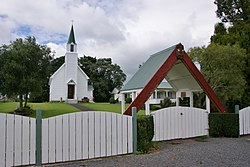Top Qs
Timeline
Chat
Perspective
Te Puna
Settlement in the Bay of Plenty, New Zealand From Wikipedia, the free encyclopedia
Remove ads
Te Puna is a rural community near Tauranga in the Bay of Plenty region of New Zealand's North Island. It is located on State Highway 2, north of Bethlehem and south of Katikati.
The local Te Puna Quarry has been redeveloped by volunteers into a park.[6]
Former National Party leader Todd Muller was raised in Te Puna in the 1970s, where his parents started a kiwifruit orchard.[7] He attended Te Puna Primary School.[8] He entered parliament at the 2014 general election as the MP for Bay of Plenty, and was National Party leader and the Leader of the Opposition from 22 May to 14 July 2020.[9]
Remove ads
Demographics
Summarize
Perspective
Te Puna statistical area, which includes Motuhoa Island, Plummers Point and Te Puna West, covers 24.71 km2 (9.54 sq mi)[4] and had an estimated population of 3,440 as of June 2024,[5] with a population density of 139 people per km2.
Te Puna had a population of 3,024 in the 2023 New Zealand census, an increase of 93 people (3.2%) since the 2018 census, and an increase of 441 people (17.1%) since the 2013 census. There were 1,521 males, 1,497 females, and 6 people of other genders in 1,059 dwellings.[12] 1.9% of people identified as LGBTIQ+. The median age was 48.1 years (compared with 38.1 years nationally). There were 525 people (17.4%) aged under 15 years, 444 (14.7%) aged 15 to 29, 1,431 (47.3%) aged 30 to 64, and 624 (20.6%) aged 65 or older.[10]
People could identify as more than one ethnicity. The results were 76.7% European (Pākehā); 30.3% Māori; 3.7% Pasifika; 2.9% Asian; 0.6% Middle Eastern, Latin American and African New Zealanders (MELAA); and 1.8% other, which includes people giving their ethnicity as "New Zealander". English was spoken by 97.5%, Māori by 12.1%, Samoan by 0.1%, and other languages by 5.9%. No language could be spoken by 1.4% (e.g. too young to talk). New Zealand Sign Language was known by 0.5%. The percentage of people born overseas was 16.1, compared with 28.8% nationally.[10]
Religious affiliations were 36.9% Christian, 0.5% Hindu, 4.0% Māori religious beliefs, 0.3% Buddhist, 0.5% New Age, 0.1% Jewish, and 1.1% other religions. People who answered that they had no religion were 49.2%, and 7.5% of people did not answer the census question.[10]
Of those at least 15 years old, 579 (23.2%) people had a bachelor's or higher degree, 1,425 (57.0%) had a post-high school certificate or diploma, and 492 (19.7%) people exclusively held high school qualifications. The median income was $42,500, compared with $41,500 nationally. 369 people (14.8%) earned over $100,000 compared to 12.1% nationally. The employment status of those at least 15 was 1,206 (48.3%) full-time, 453 (18.1%) part-time, and 45 (1.8%) unemployed.[10]
Remove ads
Marae
Te Puna has four marae belonging to the Ngāti Ranginui hapū of Pirirākau:[13][14]
- Paparoa Marae and Werahiko meeting house
- Poutūterangi Marae and Takurua meeting house
- Tutereinga Marae and meeting house
- Tawhitinui and Maka meeting house
Education
Te Puna School is a co-educational state primary school for Year 1 to 8 students,[15][16] with a roll of 226 as of July 2025.[17] The school opened in 1896 and moved to its current site in 1904.[18]
References
Wikiwand - on
Seamless Wikipedia browsing. On steroids.
Remove ads


